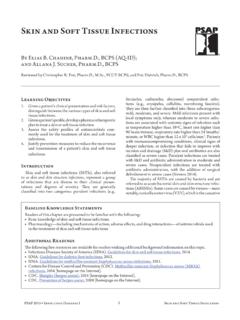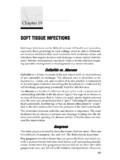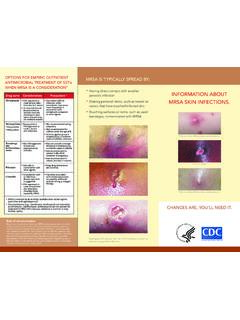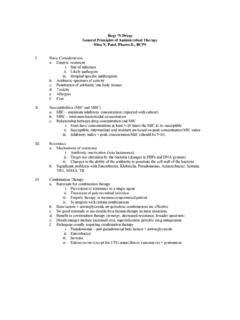Transcription of Outpatient management of skin and soft tissue infections
1 Is the lesion purulent ( , are any of the following signs present)?Fluctuance palpable fluid-filled cavity, movable, compressibleYellow or white center Central point or head Draining pus Possible to aspirate pus with needle and syringe1. Drain the lesion2. Send wound drainage for culture and susceptibility testing3. Advise patient on wound care and hygiene4. Discuss follow-up plan with patientIf systemic symptoms, severe local symptoms, immunosuppression, or failure to respond to I&DPossible cellulitis without abscess:Provide antimicrobial therapy with coverage for Streptococcus spp. and/or other suspected pathogensMaintain close follow-up Consider adding coverage for MRSA (if not provided initially), if patient does not respond For severe infections requiring inpatient management , consider consulting an infectious disease specialist. Visit for more :I&D incision and drainageMRSA methicillin-resistant S. aureusSSTI skin and soft tissue infectionPatient presents with signs/symptoms of skin infection:Redness Swelling Warmth Pain/tenderness Complaint of spider bite Outpatient management of skin and soft tissue infections in the era of community- associated MRSA The use of the CDC logo on this material does not imply endorsement of AMA products/services or activities promoted or sponsored by the antimicrobial therapy with coverage for MRSA in addition to I&D(See reverse for options)SDA:07-0827:50M:12/07:dfYesNOYes Options for empiric Outpatient antimicrobial treatment of SSTIs when MRSA is a consideration*Drug nameConsiderationsPrecautions**Clindamyc inFDA-approved to treat serious infections due to S.
2 AureusD-zone test should be performed to identify induc-ible clindamycin resistance in erythromycin-resistant isolatesClostridium difficile -associated disease, while uncommon, may occur more frequently in association with clindamycin compared to other Minocycline Doxycycline is FDA-approved to treat S. aureus skin recommended during recommended for children under the age of against group A streptococ- cus, a common cause of cellulitis, SulfamethoxazoleNot FDA-approved to treat any staphylococcal infectionMay not provide coverage for group A streptococcus, a common cause of cellulitisNot recommended for women in the third trimester of recommended for infants less than 2 months. RifampinUse only in combination with other interactions are with an infectious disease specialist is to treat complicated skin infections , including those caused by MRSA. Has been associated with myelosuppression, neuropathy and lactic acidosis during prolonged is resistant to all currently available beta-lactam agents (penicillins and cephalosporins) Fluoroquinolones ( , ciprofloxacin, levofloxacin) and macrolides (erythromycin, clarithromycin, azithromycine) are not optimal for treatment of MRSA SSTIs because resistance is common or may develop rapidly.
3 * Data from controlled clinical trials are needed to establish the comparative efficacy of these agents in treating MRSA SSTIs. Patients with signs and symptoms of severe illness should be treated as inpatients.** Consult product labeling for a complete list of potential adverse effects associated with each of decolonizationRegimens intended to eliminate MRSA colonization should not be used in patients with active infections . Decolonization regimens may have a role in preventing recurrent infections , but more data are needed to establish their efficacy and to identify optimal regimens for use in community settings. After treating active infections and reinforcing hygiene and appropriate wound care, consider consultation with an infectious disease specialist regarding use of decolonization when there are recurrent infections in an individual patient or members of a September 2007

















